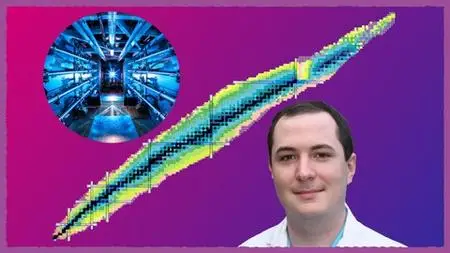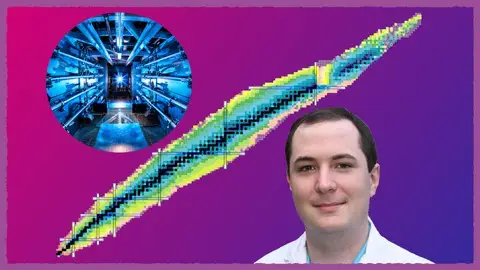Ne101: Fundamentals Of Nuclear Science And Engineering
Published 8/2023
MP4 | Video: h264, 1280x720 | Audio: AAC, 44.1 KHz
Language: English | Size: 6.60 GB | Duration: 13h 21m
Published 8/2023
MP4 | Video: h264, 1280x720 | Audio: AAC, 44.1 KHz
Language: English | Size: 6.60 GB | Duration: 13h 21m
Learn how to control radiation, nuclear fission, nuclear fusion, and nuclear medicine to benefit society as an engineer!
What you'll learn
Understand the fundamental physics behind atomic structure and isotope stability
Calculate the energy released from radioactive decay, fission, and fusion using E=mc^2
Practice the foundations of nuclear reactor design with the 4-Factor Formula and the one-speed Neutron Diffusion Equation
Study the high-level principles behind different fusion reactor designs
Learn the history behind medical applications of radiation and how technology has improved over the last century
Discover how medical radioisotopes can be used for diagnostic imaging and cancer therapy
Discover how advanced reactors work, including Small Modular Reactors, Microreactors, and Liquid-Metal Cooled Reactors
Learn the designs of Boiling Water Reactors, Pressurized Water Reactors, and CANDU reactors and how they power the US and Canada
Follow along with problem solving using Python for our number-crunching needs
Requirements
Two semesters of college Physics - Mechanics and Electromagnetism
Two semesters of college Calculus - Derivatives, Integrals, Differential Equations
Recommended for all sections: Python for Nuclear Science and Engineering
Recommended for section on Nuclear Medicine: Biology, Human Anatomy & Physiology
Description
My name is William Roysdon Murray, and welcome to Nuclear Engineering 101! There's not many online resources available online for getting started with Nuclear Engineering, so I made my own! I first learned about nuclear fission in my high school Chemistry class, and I had hundreds of questions for my teacher after that lesson - Why does both splitting an atom and fusing two atoms both produce energy? Can you make infinite energy from splitting and fusing atoms over and over again? Why are we not using more nuclear power to fight climate change when it makes so much energy without carbon dioxide? How do we have so many nuclear power plants but none of them use fusion technology?Well, I went to NC State University for about 6 years to study Nuclear Engineering and get my questions answered, and it put me about $86,000 in student debt by the time I was done. Not everyone has the time or the money for that! If you're interested in Nuclear Engineering but its not taught at your school, or you don't want to go through the hassle of enrolling in a university again, this course is for you! I've developed this course based off my first year of nuclear courses at NC State, even using the same textbook - Fundamentals of Nuclear Engineering by Shultis and Faw. My lectures will guide you through the physics concepts covered in each chapter, and the textbook will serve as your technical guide for modelling the physics with mathematics. I'll even walk you through number crunching the homework problems in Python to show you how to use the textbook to better understand nuclear science!My hope for this course is that you will discover the magic behind nuclear technology and find a specialty within nuclear that you will want to continue studying - I'll tell you where to go next at the the end of the course based on what you like too!Radiation Physics: Classical physics from Newton won't be enough for us to understand how nuclear technology works! We will cover the advances in physics made by the likes of Meitner, Schrodinger, Einstein, and others in the early 20th century in preparation for our deep dive into nuclear reactors and medicine.This course covers:Fundamentals of atomic structure, modern physics, and Einstein's Special Theory of RelativityThe various types of particle and electromagnetic radiation, and how radioactive decay processes can be modeled using differential equationsBinary nuclear reactions between bombarding radiation and target nuclei - producing new isotopes and radiation in the processHow radiation interacts with matter - calculating nuclear reaction rates in materials that and the basics of radiation shieldingNuclear Fission: Nuclear power plants are one of the largest sources of carbon-free electricity in the world. Understanding the nuclear fission process is absolutely necessary to designing the next generation of nuclear power plants to fight climate change. This course covers:Calculating the energy released from nuclear fission and chain reactionsThe anatomy of a nuclear reactor and how its components control the chain reactionDifferences between Traditional and Advanced nuclear reactors, including Small Modular Reactors and Liquid-Metal Reactors Basics of the nuclear fuel cycle - how we mine uranium, enrich it, use it in power plants, and dispose of it as nuclear waste. Nuclear waste reprocessing and recycling is also discussed!Nuclear Fusion: Fusion technology aims to harness the power of the stars with the greatest advancements in science and engineering, without the harmful waste that comes with nuclear fission technology. Dozens of companies are pursuing the fusion dream and aiming to be the first to connect a fusion reactor to the electricity grid. This course covers:Comparing the energy released and waste produced by fusion power compared to fission powerBasics of Plasma Science and Engineering that are necessary for advanced studies in fusion energyTypes of nuclear fusion reactors - Gravitational Confinement (Stars & the Sun), Magnetic Confinement (Tokamaks and Stellarators), and Inertial Confinement Fusion (High-Energy Lasers)Nuclear Medicine: Nuclear technology has brought incredible advancements in diagnostic and therapeutic medicine over the last century. Over 40 million nuclear medicine procedures are performed each year, with demand constantly increasing! This course covers:How medical radioisotopes are produced in reactors and particle acceleratorsHow these isotopes can be used to perform diagnostic imaging and destroy cancer cellsHow radiation can be applied externally without invasive surgery to irradiate tumorsHow nuclear diagnostic and therapeutic devices are built and the principles of their operationCourse LogisticsThis course is roughly equivalent to a one-semester, 4-credit university engineering course taken by STEM students in their sophomore or junior year. It is expected that students have taken two semesters of university-level physics (Mechanics and Electromagnetism) and two semesters of Calculus (Derivatives, Integrals, and basic Differential Equations). It is strongly recommended that students have taken Python for Nuclear Science and Engineering or an equivalent programming course to be able to solve homework problems involving number crunching and plotting graphs.Course Textbook: Fundamentals of Nuclear Science and Engineering, 3rd Edition by Shultis and FawSuggested Pace: 1 Chapter each Week, with selected problems for that chapter as homeworkTotal Chapters Covered: ~12 of 14 Chapters in Shultis and Faw; approximately 12 weeks of learningUpon enrolling in the course, students will be invited to join the Nuclear Learning Community to assist each other in solving technical problems and improving their understanding on topics discussed in the course. Disclaimer: No organizations mentioned in this video series have endorsed the contents of this series, nor does the lecturer claim to speak on official behalf of any organizations mentioned in this series.
Overview
Section 1: Introduction
Lecture 1 Introduction and Course Welcome
Lecture 2 Course Text - Fundamentals of Nuclear Engineering by Shultis & Faw
Lecture 3 Origins of Nuclear Science and Engineering
Lecture 4 Join the Nuclear Learning Community on Discord
Section 2: Fundamental Physics
Lecture 5 Textbook Readings - Fundamental Physics
Lecture 6 Atoms, Nuclei, and Isotopes
Lecture 7 Chart of the Nuclides
Lecture 8 Sample Problems - Atoms, Nuclei, and Isotopes
Lecture 9 Nuclear Energetics
Lecture 10 Sample Problems - Nuclear Energetics
Lecture 11 Radioactivity
Lecture 12 Sample Problems - Radioactivity
Lecture 13 Binary Nuclear Reactions
Lecture 14 Sample Problems - Binary Nuclear Reactions
Lecture 15 Radiation Interaction with Matter
Lecture 16 Sample Problems - Radiation Interaction with Matter
Section 3: Nuclear Fission
Lecture 17 Textbook Readings - Nuclear Fission
Lecture 18 Nuclear Fission and Energy Calculations
Lecture 19 Chain Reactions and Reactivity Control - Part 1 (Reactor Materials)
Lecture 20 Chain Reactions and Reacvitiy Control - Part 2 (4-Factor Formula)
Lecture 21 Sample Problems - 4-Factor Formula
Lecture 22 Chain Reactions and Reactivity Control - Part 3 (Neutron Diffusion)
Lecture 23 Chain Reactions and Reactivity Control - Part 4 (Reactor Kinetics)
Lecture 24 Sample Problem - Reactor Kinetics
Lecture 25 Chain Reactions and Reactivity Control - Part 5 (Fission Poisons and Feedback)
Lecture 26 Power Plant Principles
Lecture 27 Fission Reactor Designs - Traditional
Lecture 28 Fission Reactor Designs - Advanced
Lecture 29 Nuclear Fuel Cycle
Section 4: Nuclear Fusion
Lecture 30 Textbook Readings - Fusion
Lecture 31 Nuclear Fusion and Energy Calculations
Lecture 32 Fusion Reactor Principles - Intro to Plasma Science and Engineering
Lecture 33 Fusion Reactor Designs
Lecture 34 Sample Problem - Nuclear Fusion
Section 5: Nuclear Medicine
Lecture 35 Textbook Reading - Nuclear Medicine
Lecture 36 Isotope Production
Lecture 37 Medical Diagnostics
Lecture 38 External Radiation Therapy
Lecture 39 Internal Radiation Therapy
Lecture 40 Sample Problems - Nuclear Medicine
Section 6: Course Wrap-Up and Further Studies
Lecture 41 Nuclear Engineering - What else is there to study?
Lecture 42 Nuclear Engineering - Textbooks for Further Study
Lecture 43 Course Closure and Thank You
Individuals curious about advanced nuclear reactors - small modular reactors, thorium-fuel, liquid metal reactors, and more!,Individuals curious about nuclear fusion reactors - tokamaks, stellarators, and laser-induced fusion techniques,Current STEM university students seeking a technical introduction to nuclear engineering,Working professionals of any discipline entering the nuclear industry seeking technical training,Healthcare workers seeking greater knowledge on nuclear medicine techniques and patient effects



